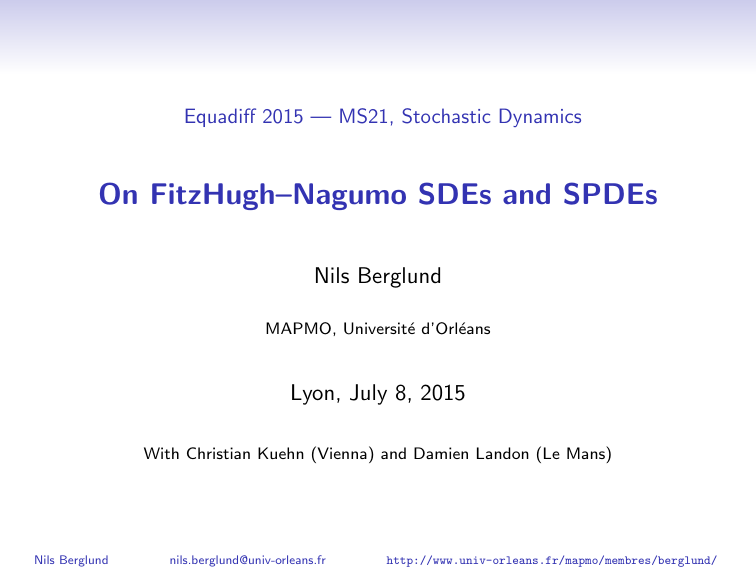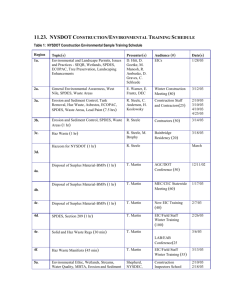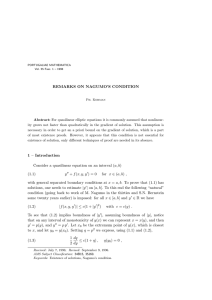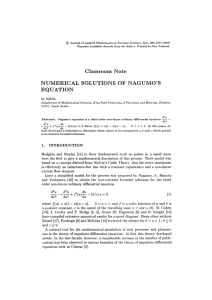On FitzHugh–Nagumo SDEs and SPDEs Nils Berglund Lyon, July 8, 2015
advertisement

Equadiff 2015 — MS21, Stochastic Dynamics
On FitzHugh–Nagumo SDEs and SPDEs
Nils Berglund
MAPMO, Université d’Orléans
Lyon, July 8, 2015
With Christian Kuehn (Vienna) and Damien Landon (Le Mans)
Nils Berglund
nils.berglund@univ-orleans.fr
http://www.univ-orleans.fr/mapmo/membres/berglund/
Plan
.
FitzHugh–Nagumo SDE
Dynamics of the membrane potential of a single neuron
Results on Poissonian vs. non-Poissonian spike statistics
[N. B. & Damien Landon, Nonlinearity 25, 2303–2335 (2012)]
.
FitzHugh–Nagumo SPDE
Dynamics of a large ensemble of neurons
Local existence result for renormalised equation via Martin Hairer’s
regularity structures
[N. B. & Christian Kuehn, preprint arXiv/1504.02953 (2015)]
On FitzHugh–Nagumo SDEs and SPDEs
July 8, 2015
1/18
Neurons and action potentials
Action potential [Dickson 00]
.
Neurons communicate via patterns of spikes
in action potentials
.
Question: effect of noise on interspike interval statistics?
.
Poisson hypothesis: Exponential distribution
⇒ Markov property
On FitzHugh–Nagumo SDEs and SPDEs
July 8, 2015
2/18
Neurons and action potentials
Action potential [Dickson 00]
.
Neurons communicate via patterns of spikes
in action potentials
.
Question: effect of noise on interspike interval statistics?
.
Poisson hypothesis: Exponential distribution
⇒ Markov property
On FitzHugh–Nagumo SDEs and SPDEs
July 8, 2015
2/18
Conduction-based models for action potential
.
Hodgkin–Huxley model (1952)
C
.
dV
dt
dn
dt
dm
dt
dh
dt
= −gK n4 (V − VK ) − gNa m3 h(V − VNa ) − gL (V − VL ) + I
= αn (V )(1 − n) − βn (V )n
= αm (V )(1 − m) − βm (V )m
= αh (V )(1 − h) − βh (V )h
FitzHugh–Nagumo model (1962)
C dV
= V − V3 + w
g dt
dw
τ
= α − βV − γw
dt
dV
dt
.
Morris–Lecar model (1982) 2d, more realistic eq for
.
Koper model (1995) 3d, generalizes FitzHugh–Nagumo
On FitzHugh–Nagumo SDEs and SPDEs
July 8, 2015
3/18
Conduction-based models for action potential
.
Hodgkin–Huxley model (1952)
C
.
dV
dt
dn
dt
dm
dt
dh
dt
= −gK n4 (V − VK ) − gNa m3 h(V − VNa ) − gL (V − VL ) + I
= αn (V )(1 − n) − βn (V )n
= αm (V )(1 − m) − βm (V )m
= αh (V )(1 − h) − βh (V )h
FitzHugh–Nagumo model (1962)
C dV
= V − V3 + w
g dt
dw
τ
= α − βV − γw
dt
dV
dt
.
Morris–Lecar model (1982) 2d, more realistic eq for
.
Koper model (1995) 3d, generalizes FitzHugh–Nagumo
On FitzHugh–Nagumo SDEs and SPDEs
July 8, 2015
3/18
Deterministic FitzHugh–Nagumo (FHN) model
εẋ = x − x 3 + y
ẏ = a − x − by
b = 0: fixed pt P = (a, a3 − a)
bifurcation parameter δ =
δ > 0:
.
P is asymptotically stable
.
the system is excitable
.
one can define a separatrix
δ < 0:
P is unstable
∃asympt. stable periodic orbit
sensitive dependence on δ:
canard (duck) phenomenon
[Callot, Diener, Diener ’78, Benoı̂t ’81, . . . ]
On FitzHugh–Nagumo SDEs and SPDEs
July 8, 2015
4/18
3a2 −1
2
Deterministic FitzHugh–Nagumo (FHN) model
εẋ = x − x 3 + y
ẏ = a − x − by
b = 0: fixed pt P = (a, a3 − a)
bifurcation parameter δ =
δ > 0:
.
P is asymptotically stable
.
the system is excitable
.
one can define a separatrix
δ < 0:
P is unstable
∃ asympt. stable periodic orbit
sensitive dependence on δ:
canard (duck) phenomenon
[Callot, Diener, Diener ’78, Benoı̂t ’81, . . . ]
On FitzHugh–Nagumo SDEs and SPDEs
July 8, 2015
4/18
3a2 −1
2
Deterministic FitzHugh–Nagumo (FHN) model
εẋ = x − x 3 + y
ẏ = a − x − by
b = 0: fixed pt P = (a, a3 − a)
bifurcation parameter δ =
δ > 0:
.
P is asymptotically stable
.
the system is excitable
.
one can define a separatrix
δ < 0:
P is unstable
∃ asympt. stable periodic orbit
sensitive dependence on δ:
canard (duck) phenomenon
[Callot, Diener, Diener ’78, Benoı̂t ’81, . . . ]
On FitzHugh–Nagumo SDEs and SPDEs
July 8, 2015
4/18
3a2 −1
2
Stochastic FHN equation
1
σ1
(1)
dxt = [xt − xt3 + yt ] dt + √ dWt
ε
ε
(2)
dyt = [a − xt − byt ] dt + σ2 dWt
.
Again b = 0 for simplicity in this talk
.
Wt , Wt : independent Wiener processes (white noise)
q
0 < σ1 , σ2 1, σ = σ12 + σ22
.
(1)
(2)
ε = 0.1
2
δ = 3a 2−1 = 0.02
σ1 = σ2 = 0.03
On FitzHugh–Nagumo SDEs and SPDEs
July 8, 2015
5/18
Mixed-mode oscillations (MMOs)
Time series t 7→ −xt for ε = 0.01, δ = 3 · 10−3 , σ = 1.46 · 10−4 , . . . , 3.65 · 10−4
On FitzHugh–Nagumo SDEs and SPDEs
July 8, 2015
6/18
Random Poincaré map
nullclines
y
D
x
separatrix
P
Y0
Y1
Y0 , Y1 , . . . substochastic Markov chain describing process killed on ∂D
Number of small oscillations N = survival time of Markov chain
On FitzHugh–Nagumo SDEs and SPDEs
July 8, 2015
7/18
Random Poincaré map
nullclines
y
D
x
separatrix
P
Y0
Y1
Y0 , Y1 , . . . substochastic Markov chain describing process killed on ∂D
Number of small oscillations N = survival time of Markov chain
Theorem 1 [B & Landon, Nonlinearity 2012]
N is asymptotically geometric: lim P{N = n + 1|N > n} = 1 − λ0
n→∞
where λ0 ∈ R+ : principal eigenvalue of the chain, λ0 < 1 if σ > 0
On FitzHugh–Nagumo SDEs and SPDEs
July 8, 2015
7/18
Proof
Transition from weak to strong noise
Theorem 2 [B & Landon, Nonlinearity 2012]
√
√
For ε and δ/ ε suff. small, ∃ κ > 0 s.t. for σ 2 6 (ε1/4 δ)2 / log( ε/δ)
n
o
(ε1/4 δ)2
. Principal eigenvalue: 1 − λ0 6 exp −κ
2
σ
n 1/4 2 o
(ε δ)
. Expected number of small osc.: E µ0 [N] > C (µ0 ) exp κ
σ2
Proof: based on construction of set A s.t. supy ∈A P y {Y1 ∈
/ A} exp. small
Linearisation around separatrix ⇒
(πε)1/4 (δ−σ12 /ε)
P{N = 1} ' Φ −
σ
R x e−y 2 /2
where Φ(x) = −∞ √2π dy
◦: 1 − λ0
∗: P{N = 1}
curve: x 7→ Φ(π
1/4
x)
On FitzHugh–Nagumo SDEs and SPDEs
+:
1/E[N]
July 8, 2015
8/18
Transition from weak to strong noise
Theorem 2 [B & Landon, Nonlinearity 2012]
√
√
For ε and δ/ ε suff. small, ∃ κ > 0 s.t. for σ 2 6 (ε1/4 δ)2 / log( ε/δ)
n
o
(ε1/4 δ)2
. Principal eigenvalue: 1 − λ0 6 exp −κ
2
σ
n 1/4 2 o
(ε δ)
. Expected number of small osc.: E µ0 [N] > C (µ0 ) exp κ
σ2
Proof: based on construction of set A s.t. supy ∈A P y {Y1 ∈
/ A} exp. small
Linearisation around separatrix ⇒
(πε)1/4 (δ−σ12 /ε)
P{N = 1} ' Φ −
σ
R x e−y 2 /2
where Φ(x) = −∞ √2π dy
1
0.9
0.8
series
1/E(N)
P(N=1)
phi
0.7
0.6
0.5
0.4
0.3
0.2
◦: 1 − λ0
∗: P{N = 1}
curve: x 7→ Φ(π
1/4
x)
On FitzHugh–Nagumo SDEs and SPDEs
+:
1/E[N]
0.1
0
−1.5
−1
−0.5
0
0.5
1
1.5
2
−µ/σ
July 8, 2015
8/18
Summary: Parameter regimes
σ
σ1 = σ2 :
1/4
2
/ε)
P{N = 1} ' Φ − (πε) (δ−σ
σ
2
3/
III
σ
ε3/4
=
δ
1/2
)
(δ ε
1/4
σ = II
δε
=
σ
see also
[Muratov & Vanden Eijnden ’08]
I
ε1/2
δ
Regime I: rare isolated spikes
Theorem 2 applies (δ ε1/2 )
Interspike interval ' exponential
Regime II: clusters of spikes
# interspike osc asympt geometric
σ = (δε)1/2 : geom(1/2)
Regime III: repeated spikes
P{N = 1} ' 1
Interspike interval ' constant
On FitzHugh–Nagumo SDEs and SPDEs
July 8, 2015
9/18
FitzHugh–Nagumo SPDE
∂t u = ∆u + u − u 3 + v + ξ
∂t v = a1 u + a2 v
u = u(t, x) ∈ R, v = v (t, x) ∈ Rn , (t, x) ∈ D = R+ × Td , d = 2, 3
. ξ(t, x) Gaussian space-time white noise: E ξ(t, x)ξ(s, y ) = δ(t − s)δ(x − y )
.
ξ: distribution defined by hξ, ϕi = Wϕ , {Wh }h∈L2 (D) , E[Wh Wh0 ] = hh, h0 i
(Link to simulation)
On FitzHugh–Nagumo SDEs and SPDEs
July 8, 2015
10/18
Main result
Mollified noise: ξ ε = %ε ∗ ξ 1
% εt2 , xε with ρ compactly supported, integral 1
where %ε (t, x) = εd+2
Theorem [B & Kuehn, preprint 2015, arXiv/1504.02953]
There exists a choice of renormalisation constant C (ε), limε→0 C (ε) = ∞,
such that
∂t u ε = ∆u ε + [1 + C (ε)]u ε − (u ε )3 + v ε + ξ ε
∂t v ε = a1 u ε + a2 v ε
admits a sequence of local solutions (u ε , v ε ), converging in probability to a
limit (u, v ) as ε → 0.
Local solution means up to a random possible explosion time
. Initial conditions should be in appropriate Hölder spaces
. C (ε) log(ε−1 ) for d = 2 and C (ε) ε−1 for d = 3
. Similar results for general cubic nonlinearity and v ∈ Rn
.
On FitzHugh–Nagumo SDEs and SPDEs
July 8, 2015
11/18
Mild solutions of SPDE
∂t u = ∆u + F (u) + ξ
Construction of mild solution via ZDuhamel formula:
. ∂t u = ∆u
⇒ u(t, x) = G (t, x − y )u0 (y ) dy =: (e∆t u0 )(x)
.
where G (t, x): heat kernel (compatible with bc)
Z t
∆t
∂t u = ∆u + f
⇒ u(t, x) = (e u0 )(x) +
e∆(t−s) f (s, ·)(x) ds
0
Notation: u = Gu0 + G ∗ f
⇒
.
∂t u = ∆u + ξ
.
∂t u = ∆u + ξ + F (u)
u = Gu0 + G ∗ ξ (stochastic convolution)
⇒
u = Gu0 + G ∗ [ξ + F (u)]
Aim: use Banach’s fixed-point theorem — but which function space?
On FitzHugh–Nagumo SDEs and SPDEs
July 8, 2015
12/18
Mild solutions of SPDE
∂t u = ∆u + F (u) + ξ
Construction of mild solution via ZDuhamel formula:
. ∂t u = ∆u
⇒ u(t, x) = G (t, x − y )u0 (y ) dy =: (e∆t u0 )(x)
.
where G (t, x): heat kernel (compatible with bc)
Z t
∆t
∂t u = ∆u + f
⇒ u(t, x) = (e u0 )(x) +
e∆(t−s) f (s, ·)(x) ds
0
Notation: u = Gu0 + G ∗ f
⇒
.
∂t u = ∆u + ξ
.
∂t u = ∆u + ξ + F (u)
u = Gu0 + G ∗ ξ
⇒
(stochastic convolution)
u = Gu0 + G ∗ [ξ + F (u)]
Aim: use Banach’s fixed-point theorem — but which function space?
On FitzHugh–Nagumo SDEs and SPDEs
July 8, 2015
12/18
Mild solutions of SPDE
∂t u = ∆u + F (u) + ξ
Construction of mild solution via ZDuhamel formula:
. ∂t u = ∆u
⇒ u(t, x) = G (t, x − y )u0 (y ) dy =: (e∆t u0 )(x)
.
where G (t, x): heat kernel (compatible with bc)
Z t
∆t
∂t u = ∆u + f
⇒ u(t, x) = (e u0 )(x) +
e∆(t−s) f (s, ·)(x) ds
0
Notation: u = Gu0 + G ∗ f
⇒
.
∂t u = ∆u + ξ
.
∂t u = ∆u + ξ + F (u)
u = Gu0 + G ∗ ξ
⇒
(stochastic convolution)
u = Gu0 + G ∗ [ξ + F (u)]
Aim: use Banach’s fixed-point theorem — but which function space?
On FitzHugh–Nagumo SDEs and SPDEs
July 8, 2015
12/18
Schauder estimates and fixed-point equation
Csα : Hölder space for parabolic scaling k(t, x)ks = |t|1/2 +
Pd
If α < 0, f ∈ Csα
y −x
1
η( s−t
δ2 , δ )
δ d+2
δ
|hf , ηt,x
i| 6 C δ α
⇔
δ
where ηt,x
(s, y ) =
i=1 |xi |
Schauder estimate
f ∈ Csα
G ∗ f ∈ Csα+2
⇒
Fact: in dimension d, space-time white noise ξ ∈ Csα a.s. ∀α < − d+2
2
Fixed-point equation: u = Gu0 + G ∗ [ξ + F (u)]
−3/2−
.
d = 1: ξ ∈ Cs
.
d = 3: ξ ∈ Cs
.
−5/2−
−2−
d = 2: ξ ∈ Cs
1/2−
⇒ G ∗ ξ ∈ Cs
⇒ F (u) defined
−1/2−
⇒ G ∗ ξ ∈ Cs
0−
⇒ G ∗ ξ ∈ Cs
⇒ F (u) not defined
⇒ F (u) not defined
Boundary case, can be treated with Besov spaces
[Da Prato and Debussche 2003]
On FitzHugh–Nagumo SDEs and SPDEs
July 8, 2015
13/18
Schauder estimates and fixed-point equation
Csα : Hölder space for parabolic scaling k(t, x)ks = |t|1/2 +
Pd
If α < 0, f ∈ Csα
y −x
1
η( s−t
δ2 , δ )
δ d+2
δ
|hf , ηt,x
i| 6 C δ α
⇔
δ
where ηt,x
(s, y ) =
i=1 |xi |
Schauder estimate
f ∈ Csα
G ∗ f ∈ Csα+2
⇒
Fact: in dimension d, space-time white noise ξ ∈ Csα a.s. ∀α < − d+2
2
Fixed-point equation: u = Gu0 + G ∗ [ξ + F (u)]
−3/2−
.
d = 1: ξ ∈ Cs
.
d = 3: ξ ∈ Cs
.
−5/2−
−2−
d = 2: ξ ∈ Cs
1/2−
⇒ G ∗ ξ ∈ Cs
⇒ F (u) defined
−1/2−
⇒ G ∗ ξ ∈ Cs
0−
⇒ G ∗ ξ ∈ Cs
⇒ F (u) not defined
⇒ F (u) not defined
Boundary case, can be treated with Besov spaces
[Da Prato and Debussche 2003]
On FitzHugh–Nagumo SDEs and SPDEs
July 8, 2015
13/18
Regularity structures
Basic idea of Martin Hairer [Inventiones Mathematicae, 2014]:
Lift mollified fixed-point equation
u = Gu0 + G ∗ [ξ ε + F (u)]
to a larger space called a Regularity structure
SM
M(u0 , Z ε )
UM
RM
MΨ
(u0 , ξ ε )
uε
S̄M
.
u ε = S̄(u0 , ξ ε ): classical solution of mollified equation
.
U = S(u0 , Z ε ): solution map in regularity structure
.
S and R are continuous (in suitable topology)
.
Renormalisation: modification of the lift Ψ
On FitzHugh–Nagumo SDEs and SPDEs
July 8, 2015
14/18
Regularity structures
Basic idea of Martin Hairer [Inventiones Mathematicae, 2014]:
Lift mollified fixed-point equation
u = Gu0 + G ∗ [ξ ε + F (u)]
to a larger space called a Regularity structure
SM
(u0 , MZ ε )
UM
RM
MΨ
(u0 , ξ ε )
û ε
S̄M
.
u ε = S̄(u0 , ξ ε ): classical solution of mollified equation
.
U = S(u0 , Z ε ): solution map in regularity structure
.
S and R are continuous (in suitable topology)
.
Renormalisation: modification of the lift Ψ
On FitzHugh–Nagumo SDEs and SPDEs
July 8, 2015
14/18
Regularity structure for ∂t u = ∆u − u 3 + ξ
New symbols: Ξ, representing ξ, Hölder exponent |Ξ|s = α0 = − d+2
2 −κ
New symbols: I(τ ), representing G ∗ f , Hölder exponent |I(τ )|s = |τ |s + 2
New symbols: τ σ, Hölder exponent |τ σ|s = |τ |s + |σ|s
On FitzHugh–Nagumo SDEs and SPDEs
July 8, 2015
15/18
Regularity structure for ∂t u = ∆u − u 3 + ξ
New symbols: Ξ, representing ξ, Hölder exponent |Ξ|s = α0 = − d+2
2 −κ
New symbols: I(τ ), representing G ∗ f , Hölder exponent |I(τ )|s = |τ |s + 2
New symbols: τ σ, Hölder exponent |τ σ|s = |τ |s + |σ|s
|τ |s
α0
3α0 + 6
2α0 + 4
d =3
− 52 − κ
− 32 − 3κ
−1 − 2κ
d =2
−2 − κ
0 − 3κ
0 − 2κ
I(I(Ξ)3 )I(Ξ)2
I(Ξ)
5α0 + 12
α0 + 2
− 12 − 5κ
− 12 − κ
2 − 5κ
0−κ
I(I(Ξ)3 )I(Ξ)
I(I(Ξ)2 )I(Ξ)2
I(Ξ)2 Xi
1
4α0 + 10
4α0 + 10
2α0 + 5
0
0 − 4κ
0 − 4κ
0 − 2κ
0
2 − 4κ
2 − 4κ
1 − 2κ
0
3α0 + 8
...
1
2
2 − 3κ
...
τ
Ξ
I(Ξ)3
I(Ξ)2
I(I(Ξ)3 )
...
On FitzHugh–Nagumo SDEs and SPDEs
Symbol
Ξ
Xi
1
...
− 3κ
...
July 8, 2015
15/18
The case of the FitzHugh–Nagumo equations
Fixed-point equation
u(t, x) = G ∗ [ξ ε + u − u 3 + v ](t, x) + Gu0 (t, x)
Z t
v (t, x) =
u(s, x) e(t−s)a2 a1 ds + eta2 v0
0
Lifted version
U = I[Ξ + U − U 3 + V ] + Gu0
V = EU + Qv0
where E is an integration map which is not regularising in space
New symbols E(I(Ξ)) = , etc. . .
We expect U, and thus also V to be α-Hölder for α < − 12
Thus I(U − U 3 + V ) should be well-defined
The standard theory has to be extended, because E does not correspond
to a smooth kernel
On FitzHugh–Nagumo SDEs and SPDEs
July 8, 2015
16/18
Why do we need to renormalise?
Model (Π, Γ): Πz τ distribution describing τ near z ∈ Rd+1 , Πz̄ = Πz Γzz̄
Let Gε = G ∗ %ε where %ε is the mollifier
Z
ε
(Πz̄ )(z) = (G ∗ ξ )(z) = (Gε ∗ ξ)(z) =
Gε (z − z1 )ξ(z1 ) dz1
belongs to first Wiener chaos, limit ε → 0 well-defined
ZZ
ε
2
(Πz̄ )(z) = (G ∗ ξ )(z) =
Gε (z − z1 )Gε (z − z2 )ξ(z1 )ξ(z2 ) dz1 dz2
diverges as ε → 0
Wick product: ξ(z1 ) ξ(z2 ) = ξ(z1 )ξ(z2 ) − δ(z1 − z2 )
ZZ
(Πz̄ )(z) =
Z
Gε (z − z1 )Gε (z − z2 )ξ(z1 ) ξ(z2 ) dz1 dz2 +
´¹¹ ¹ ¹ ¹ ¹ ¹ ¹ ¹ ¹ ¹ ¹ ¹ ¹ ¹ ¹ ¹ ¹ ¹ ¹ ¹ ¹ ¹ ¹ ¹ ¹ ¹ ¹ ¹ ¹ ¹ ¹ ¹ ¹ ¹ ¹ ¹ ¹ ¹ ¹ ¹ ¹ ¹ ¹ ¹ ¹ ¹ ¹ ¹ ¹ ¹ ¹ ¹ ¹ ¹ ¹ ¹ ¹ ¹ ¹ ¹ ¹ ¹ ¹ ¹ ¹ ¹ ¹ ¹ ¹ ¹ ¹ ¹ ¹ ¹ ¹ ¹ ¸ ¹ ¹ ¹ ¹ ¹ ¹ ¹ ¹ ¹ ¹ ¹ ¹ ¹ ¹ ¹ ¹ ¹ ¹ ¹ ¹ ¹ ¹ ¹ ¹ ¹ ¹ ¹ ¹ ¹ ¹ ¹ ¹ ¹ ¹ ¹ ¹ ¹ ¹ ¹ ¹ ¹ ¹ ¹ ¹ ¹ ¹ ¹ ¹ ¹ ¹ ¹ ¹ ¹ ¹ ¹ ¹ ¹ ¹ ¹ ¹ ¹ ¹ ¹ ¹ ¹ ¹ ¹ ¹ ¹ ¹ ¹ ¹ ¹ ¹ ¹ ¹ ¶
in 2nd Wiener chaos, bdd
Gε (z − z1 )2 dz1
´¹¹ ¹ ¹ ¹ ¹ ¹ ¹ ¹ ¹ ¹ ¹ ¹ ¹ ¹ ¹ ¹ ¹ ¹ ¹ ¹ ¹ ¹ ¹ ¹ ¹¸ ¹ ¹ ¹ ¹ ¹ ¹ ¹ ¹ ¹ ¹ ¹ ¹ ¹ ¹ ¹ ¹ ¹ ¹ ¹ ¹ ¹ ¹ ¹ ¹ ¹ ¶
C1 (ε)→∞
b z̄ )(z) = (Πz̄ )(z) − C1 (ε)
Renormalised model: (Π
On FitzHugh–Nagumo SDEs and SPDEs
July 8, 2015
17/18
Why do we need to renormalise?
Model (Π, Γ): Πz τ distribution describing τ near z ∈ Rd+1 , Πz̄ = Πz Γzz̄
Let Gε = G ∗ %ε where %ε is the mollifier
Z
ε
(Πz̄ )(z) = (G ∗ ξ )(z) = (Gε ∗ ξ)(z) =
Gε (z − z1 )ξ(z1 ) dz1
belongs to first Wiener chaos, limit ε → 0 well-defined
ZZ
ε
2
(Πz̄ )(z) = (G ∗ ξ )(z) =
Gε (z − z1 )Gε (z − z2 )ξ(z1 )ξ(z2 ) dz1 dz2
diverges as ε → 0
Wick product: ξ(z1 ) ξ(z2 ) = ξ(z1 )ξ(z2 ) − δ(z1 − z2 )
ZZ
(Πz̄ )(z) =
Z
Gε (z − z1 )Gε (z − z2 )ξ(z1 ) ξ(z2 ) dz1 dz2 +
´¹¹ ¹ ¹ ¹ ¹ ¹ ¹ ¹ ¹ ¹ ¹ ¹ ¹ ¹ ¹ ¹ ¹ ¹ ¹ ¹ ¹ ¹ ¹ ¹ ¹ ¹ ¹ ¹ ¹ ¹ ¹ ¹ ¹ ¹ ¹ ¹ ¹ ¹ ¹ ¹ ¹ ¹ ¹ ¹ ¹ ¹ ¹ ¹ ¹ ¹ ¹ ¹ ¹ ¹ ¹ ¹ ¹ ¹ ¹ ¹ ¹ ¹ ¹ ¹ ¹ ¹ ¹ ¹ ¹ ¹ ¹ ¹ ¹ ¹ ¹ ¹ ¸ ¹ ¹ ¹ ¹ ¹ ¹ ¹ ¹ ¹ ¹ ¹ ¹ ¹ ¹ ¹ ¹ ¹ ¹ ¹ ¹ ¹ ¹ ¹ ¹ ¹ ¹ ¹ ¹ ¹ ¹ ¹ ¹ ¹ ¹ ¹ ¹ ¹ ¹ ¹ ¹ ¹ ¹ ¹ ¹ ¹ ¹ ¹ ¹ ¹ ¹ ¹ ¹ ¹ ¹ ¹ ¹ ¹ ¹ ¹ ¹ ¹ ¹ ¹ ¹ ¹ ¹ ¹ ¹ ¹ ¹ ¹ ¹ ¹ ¹ ¹ ¹ ¶
in 2nd Wiener chaos, bdd
Gε (z − z1 )2 dz1
´¹¹ ¹ ¹ ¹ ¹ ¹ ¹ ¹ ¹ ¹ ¹ ¹ ¹ ¹ ¹ ¹ ¹ ¹ ¹ ¹ ¹ ¹ ¹ ¹ ¹¸ ¹ ¹ ¹ ¹ ¹ ¹ ¹ ¹ ¹ ¹ ¹ ¹ ¹ ¹ ¹ ¹ ¹ ¹ ¹ ¹ ¹ ¹ ¹ ¹ ¹ ¶
C1 (ε)→∞
b z̄ )(z) = (Πz̄ )(z) − C1 (ε)
Renormalised model: (Π
On FitzHugh–Nagumo SDEs and SPDEs
July 8, 2015
17/18
Why do we need to renormalise?
Model (Π, Γ): Πz τ distribution describing τ near z ∈ Rd+1 , Πz̄ = Πz Γzz̄
Let Gε = G ∗ %ε where %ε is the mollifier
Z
ε
(Πz̄ )(z) = (G ∗ ξ )(z) = (Gε ∗ ξ)(z) =
Gε (z − z1 )ξ(z1 ) dz1
belongs to first Wiener chaos, limit ε → 0 well-defined
ZZ
ε
2
(Πz̄ )(z) = (G ∗ ξ )(z) =
Gε (z − z1 )Gε (z − z2 )ξ(z1 )ξ(z2 ) dz1 dz2
diverges as ε → 0
Wick product: ξ(z1 ) ξ(z2 ) = ξ(z1 )ξ(z2 ) − δ(z1 − z2 )
ZZ
(Πz̄
)(z) =
Z
Gε (z − z1 )Gε (z − z2 )ξ(z1 ) ξ(z2 ) dz1 dz2 +
´¹¹ ¹ ¹ ¹ ¹ ¹ ¹ ¹ ¹ ¹ ¹ ¹ ¹ ¹ ¹ ¹ ¹ ¹ ¹ ¹ ¹ ¹ ¹ ¹ ¹ ¹ ¹ ¹ ¹ ¹ ¹ ¹ ¹ ¹ ¹ ¹ ¹ ¹ ¹ ¹ ¹ ¹ ¹ ¹ ¹ ¹ ¹ ¹ ¹ ¹ ¹ ¹ ¹ ¹ ¹ ¹ ¹ ¹ ¹ ¹ ¹ ¹ ¹ ¹ ¹ ¹ ¹ ¹ ¹ ¹ ¹ ¹ ¹ ¹ ¹ ¹ ¸ ¹ ¹ ¹ ¹ ¹ ¹ ¹ ¹ ¹ ¹ ¹ ¹ ¹ ¹ ¹ ¹ ¹ ¹ ¹ ¹ ¹ ¹ ¹ ¹ ¹ ¹ ¹ ¹ ¹ ¹ ¹ ¹ ¹ ¹ ¹ ¹ ¹ ¹ ¹ ¹ ¹ ¹ ¹ ¹ ¹ ¹ ¹ ¹ ¹ ¹ ¹ ¹ ¹ ¹ ¹ ¹ ¹ ¹ ¹ ¹ ¹ ¹ ¹ ¹ ¹ ¹ ¹ ¹ ¹ ¹ ¹ ¹ ¹ ¹ ¹ ¹ ¶
in 2nd Wiener chaos, bdd
b z̄
Renormalised model: (Π
On FitzHugh–Nagumo SDEs and SPDEs
)(z) = (Πz̄
Gε (z − z1 )2 dz1
´¹¹ ¹ ¹ ¹ ¹ ¹ ¹ ¹ ¹ ¹ ¹ ¹ ¹ ¹ ¹ ¹ ¹ ¹ ¹ ¹ ¹ ¹ ¹ ¹ ¹¸ ¹ ¹ ¹ ¹ ¹ ¹ ¹ ¹ ¹ ¹ ¹ ¹ ¹ ¹ ¹ ¹ ¹ ¹ ¹ ¹ ¹ ¹ ¹ ¹ ¹ ¶
C1 (ε)→∞
)(z) − C1 (ε)
July 8, 2015
17/18
Concluding remarks
.
Noise can induce spikes that may have non-Poisson interval statistics
.
Important tools: random Poincaré maps and quasistationary
distributions
.
Local existence result for FitzHugh–Nagumo SPDE
Global existence: proved for Allen–Cahn in 2D [Mourrat and Weber]
.
More quantitative results?
Some references
. N. B. & Damien Landon, Mixed-mode oscillations and interspike interval statistics
in the stochastic FitzHugh–Nagumo model, Nonlinearity 25, 2303–2335 (2012)
. N. B., Barbara Gentz & Christian Kuehn, From random Poincaré maps to
stochastic mixed-mode-oscillation patterns, JDDE 27, 83–136 (2015)
. N. B. & Christian Kuehn, Regularity structures and renormalisation of
FitzHugh–Nagumo SPDEs in three space dimensions, preprint arXiv/1504.02953
. Martin Hairer, A theory of regularity structures, Invent. Math. 198 (2), 269–504
(2014)
. Martin Hairer, Introduction to Regularity Structures, lecture notes (2013)
On FitzHugh–Nagumo SDEs and SPDEs
July 8, 2015
18/18
Proof of asymptotically geometric distribution
Theorem 1 [B & Landon, Nonlinearity 2012]
N is asymptotically geometric: lim P{N = n + 1|N > n} = 1 − λ0
n→∞
where λ0 ∈ (0, 1) if σ > 0 is principal eigenvalue of the chain
Proof:
Markov chain on E , kernel K with density k [Ben Arous, Kusuoka, Stroock ’84]
.
λ0 6 sup K (x, E ) < 1 by ellipticity (k bounded below)
x∈E
.
µ0
P {N > n} = P µ0 {Xn ∈ E } =
R
P µ0 {N > n} = P µ0 {Xn ∈ E } =
R
E
E
µ0 (dx)K n (x, E )
µ0 (dx)λn0 h0 (x)kh0∗ k1 [1 + O((|λ1 |/λ0 )n )]
P µ0 {N > n} = P µ0 {Xn ∈ E } = λn0 hµ0 , h0 ikh0∗ k1 [1 + O((|λ1 |/λ0 )n )]
R R
. P µ0 {N = n + 1} =
µ (dx)K n (x, dy )[1 − K (y , E )]
E E 0
P µ0 {N = n + 1} = λn0 (1 − λ0 )hµ0 , h0 ikh0∗ k1 [1 + O((|λ1 |/λ0 )n )]
.
Existence of spectral gap follows from positivity condition [Birkhoff ’57]
Back
On FitzHugh–Nagumo SDEs and SPDEs
July 8, 2015
19/18







